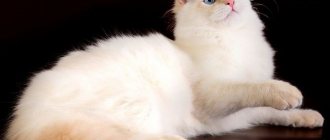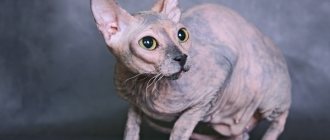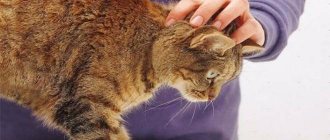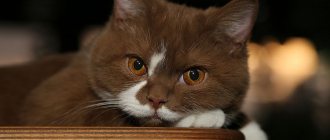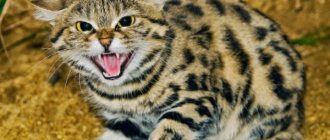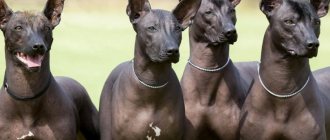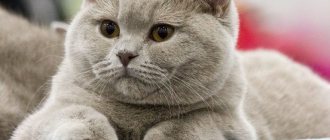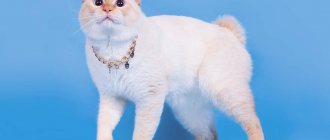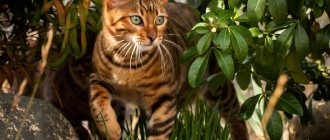Savannah
This animal amazes others with many of its characteristics, namely height, weight, etc. But the main surprise awaits those who decide to buy a kitten of this breed for themselves. The price is truly astronomical, although it is due to the fact that this breed has only 1 thousand individuals, and the first offspring were born only in the spring of 1986.
The basis of this breed was the domestic cat and the wild African serval. As a result, an animal was born, distinguished by its unique color, large ears, long legs, as well as fantastic jumping ability (up to 3 meters) and love for the water element. Savannah not only loves to swim, she is an excellent swimmer and is able to cover enormous distances across the surface of the water.
In addition, the Savannah has a developed intellect, she has an easy-going character and is devoted to her owner.
Siamese cat
Once upon a time, only nobles and members of the royal family of Siam (modern Thailand) could pet these elegant beauties with bright blue eyes and color point coloring. They were prohibited from being exported outside the country.
In 1871, Siamese cats, presented to the English consul by the King of Siam, appeared at the first Crystal Palace National Competition in England. Journalists immediately called them “unnatural nightmare cats.” However, ordinary Englishmen did not agree with the press representatives. They were struck by the unusual color of the animals. Currently, Siamese cats have about 40 coat color options.
It is curious that representatives of the Siamese-oriental group can change the tonality and pitch of sound in order to convey their feelings and desires to the owner.
We invite you to read: Demodicosis in cats - symptoms, treatment and prevention
Maine Coon
This breed rightfully takes second place in the list of the largest cat breeds. Representatives of this breed have a weight of about 15 kilograms and a rather menacing appearance. At the same time, they find a “common language” with both adults and children, without offending pets either.
These animals have a characteristic color and a powerful tail, like raccoons. Thanks to these features, the name appeared, which translated means “Mensky raccoon”. Maine is the name of the state in the United States where the ancestors of Maine Coons were once kept on farms.
The breed is practically devoid of disadvantages, with the exception of its astronomical cost. Cats are easy to train and always demonstrate nobility, intelligence, calm disposition and grace.
10 ABNORMALLY BIG CATS IN THE WORLD
Pixie bob
thehappycatsite.com
- Average weight: for cats - up to 5 kg, for cats - up to 10 kg.
- Life expectancy: up to 12 years.
Outwardly, the pixie-bob resembles a lynx, although it is not its direct relative. The breed was bred at the end of the last century in the USA, and its ancestors were two animals with a characteristic appearance. A distinctive feature is a short tail. And these cats often have polydactyly - in other words, they can have up to seven toes on their paws.
Short-tailed elves (this is how the name of the breed is translated) are very sociable. They willingly spend time next to a person and become very attached to him, showing literally dog-like devotion. And thanks to their calm nature, these cats get along well with children.
Pixie bobs are quite active, love outdoor games and don’t mind frolicking in the water. They learn quickly, can remember simple commands and tricks, such as fetching thrown objects, and walk calmly on a harness.
Chausie
It is considered not only one of the largest, but, at the same time, the rarest breed, the weight of which can reach at least 14 and a half kilograms.
The breed was born in 1990 and is a hybrid of an Abyssinian cat and a jungle cat. The jungle cat prefers to live in swamps, which is why it is also called the swamp lynx.
As a result of hard work, breeders managed to get a cat that has the power of a predator and the docile nature of a domestic cat. Chausie cats are quite strong cats, with an athletically complex body, a large (comparatively) head, large ears, and green or yellow eyes. Despite such external characteristics, the breed is devoted to its owner and feels great around children.
Somali cat
Compact, flexible and muscular. The head is wedge-shaped with a thin contour and widely spaced ears. Almond-shaped eyes are amber, hazel or green. The paws are long with tufts of hair. The coat is soft, thick, close to the body. The beast is elegant, agile and agile. He has a good-natured character, is shy and not very brave, avoids conflict situations and would rather leave than show dissatisfaction or aggression. Although he easily adapts to new situations, he feels bad on the street.
| Somali breed size chart | |||
| Height at withers (cm) | Body length(cm) | Weight, kg) | |
| Cat | 34 | 70 | 6 |
| Cat | 28 | 60 | 4,5 |
| Kitten (3 months) | 1,5 | ||
To gradually gain weight, you should not abuse fatty foods, but give more vitamins.
Ragamuffin
California is considered the birthplace of this breed, and it was born as a result of the efforts of Ann Baker, who decided to modify the Ragdoll. So she began to crossbreed the Ragdoll with other cat breeds, such as the Persian, the Yard Longhair, and the Himalayan.
As a result of these efforts, a breed was born that was called “cherub,” but at the last moment it was renamed and began to be called “ragamuffin,” which means “ragamuffin.”
Adults weigh at least 10 kilograms and acquire impressive sizes, although they mature only at 4 years of age. The breed does not have a beautiful, proportional physique, but it is distinguished by a variety of coat colors.
Turkish van
Eyes are the pride of the breed
Looking at luxurious, fluffy cats, the question of their origin involuntarily arises. And their origin is curious - the Murki and Barsiki of Turkish streets, aboriginal animals. Only thanks to two Englishwomen who went to Turkey in 1955, the world learned about the new breed. Sonia and Laura paid attention to the beautiful animals; the girls managed to take a couple of kittens with them. They laid the foundation for a new breed, registered in 1969.
Turkish Vans are distinguished by their powerful physique and strength. The weight of an adult cat is 7-10 kg, cats are slightly smaller. A distinctive feature of the representatives of the breed is semi-long wool without undercoat.
Another feature is the color: completely white, a little red on the head (near the ears) and a completely copper tail.
Representatives of the breed love to play; this trait remains with them throughout their lives. Also, Turkish Vans are excellent swimmers, they love water and bathe often. When getting such a cat, you should give it bath days, giving it the opportunity to swim.
Among these cats there are many long-livers, having crossed the 17-year mark. Average life expectancy is 13 years.
In Russia, only one nursery is best known, breeding Turkish Vans.
Kurilian Bobtail
The list of the largest cat breeds is replenished with another giant, since adult individuals can weigh at least 7 kilograms.
This breed of cats was once moved from the Kuril Islands to the mainland at the end of the last century.
The breed is distinguished by the original shape of its tail, which is quite short (only 8 cm maximum) and somewhat resembles a pom-pom. If a cat of this breed has a tail longer than 8 cm, then this is considered a fault of the individual, and if its length is only 12 cm, then the cat can be removed from the competition.
Kuril bobtails are not afraid of either moisture or frost, although they do not like to swim, but at the same time they are excellent at hunting fish.
The behavior of this breed of cat is somewhat reminiscent of the behavior of dogs, since they are very curious, are highly active and never refuse long walks and fun games, involving various toys, where they carry them in their owner’s teeth, like dogs.
American Bobtail
The head is wide, but proportional to the body. This breed has prominent cheeks and a wide nose. The jaws are very strong. The eyes of bobtails are almond-shaped, distant from each other. The medium-sized ears are set quite high on the head and have slightly rounded ends. The figure is squat, the body is muscular, slightly elongated. Cats of this breed are friendly, sociable, intelligent, energetic and active, and love to play alone or with their guardian. They are not aggressive towards other animals and people, and become attached to all family members. They have an excellent ability to leave closed rooms and can open doors by jumping on the door handle.
| American Bobtail Size Chart | |||
| Height at withers (cm) | Body length(cm) | Weight, kg) | |
| Cat | 38 | 95 | 8 |
| Cat | 36 | 85 | 7 |
| Kitten (3 months) | 1,5 | ||
It is necessary to monitor the diet of the American Bobtail. Depending on the type of coat and lifestyle of the animal, the owner must choose the right food. Representatives of the breed need active training. Kittens grow slowly and reach adult size at about 3 years of age.
Norwegian Forest Cat
Due to the fact that the forest cat has long, fluffy fur, it seems that this animal is quite large. In fact, adults generally weigh no more than 9 kilograms.
There is a legend that this breed of cats was brought to Scandinavia by the Vikings in the holds of their ships. What these cats did on ships was to catch rodents, saving sailors from hunger and the bubonic plague, which was spread by rats.
In northern latitudes, cats became slightly domesticated, beginning to live next to humans. In 1934, the stage of breeding work with the Norwegian Forest Cat began, for which purebred representatives of this breed were sought throughout the world, as well as throughout the country. In 1976, the breed was officially recognized throughout the world.
The Norwegian cat is distinguished by its stable psyche; in addition, it is brave and strong, with the skills of a real hunter. These cats are not afraid to be with dogs that have the same easy-going nature, or near children. The Norwegian Forest Cat is considered to be one of the smartest.
What are the large breeds of cats?
The modern fashion for large domestic cats dictates the development of large breeds with an exotic appearance. Although, of course, the very word “fashion” is inappropriate in relation to living creatures that live next to us and become our favorites - practically members of the family. Interestingly, most giant cat breeds came to us from the North American continent.
Savannah
The Savannah cat is one of the most unusual domestic cats, a record holder not only in size, but also in cost. This rare exclusive breed was conceived and created not by nature, but by a person who decided to cross a wild animal with a pet. The breed was created in 1986, after a series of unsuccessful experiments in mating the African predator serval with various breeds of cats.
The first generation Savannah (F-1), which has half the blood of a serval, reaches sixty centimeters at the withers and weighs an average of fifteen kilograms. The F-2 generation already has 29 percent wild blood - the dimensions of such a hybrid are reduced to 50–55 centimeters and 10 kilograms, respectively. Each subsequent generation will be even smaller in size, and the fifth generation Swanna is practically no different from an ordinary domestic cat.
Savannah in the third generation no longer looks much like a serval
Finally, the efforts of American breeders were crowned with success - the first offspring were obtained - not only viable, but also reproductive. At the initial stage, pairs of servals consisted of the following breeds:
- Egyptian Mau;
- Ocicats;
- orientals;
- Bengals.
Now, for the sake of genetic stabilization of the hybrid population, the blood of domestic cats is no longer flowing. Matings involve either pairs from two savannahs, or a savannah is crossed with a serval. The bold experiment was aimed at creating an exotic, huge cat with the appearance of a wild predator and an affectionate, docile character.
If in general everything turned out quite well in terms of appearance, then in terms of disposition and behavior, savannahs do not always turn out to be “sofa cushions.” And in cases where the genetics of the predator wins, the exclusive offspring turn out to be unadapted to life in an apartment and even unsafe for humans. Therefore, despite the fact that the breed is the fruit of American selection, in some states of the country Savannahs are still prohibited not only for breeding, but also for keeping - this genetic mix has turned out to be too unpredictable.
The first generation Savannah is often difficult to distinguish from a Serval
The further the savannah is from its wild ancestor, the less animal exoticism it has and the fewer problems there are with keeping it in the house. The first generation Savannah (F-1), which has half the blood of a serval, reaches sixty centimeters at the withers and weighs an average of fifteen kilograms. These cats are tall-legged and have an elongated, predatory body. The F-2 generation already has 29 percent wild blood - the dimensions of such a hybrid are reduced to 50–55 centimeters and 10 kilograms, respectively. Each subsequent generation will be even smaller in size, and the fifth generation Swanna is practically no different from an ordinary domestic cat.
The ideal savannah is very tolerant of people
Nevertheless, the demand for kittens of this breed remains very high. Potential buyers are not deterred by either possible difficulties or the high price - the offspring of the first generations can cost about twenty thousand dollars or even more. This is despite the fact that most animals are sold only sterilized - which, according to the official version of the breeders, should help reduce their potential aggression.
Video: Savannah is the largest and most expensive cat
Maine Coon
As for the origin of this breed, there are several versions that are more reminiscent of legends. Americans are rightfully proud of these magnificent cats and sometimes attribute extraordinary, almost mystical properties to them.
The name “Maine Coon” itself literally translates as “Maine raccoon”, that is, “raccoon from Maine”. One of the common stories is that this breed is a cross between local forest cats and... raccoons. Any zoologist will only laugh at such tales, but take a closer look: in both the appearance and behavior of the Maine Coon there really is something of a raccoon. Many of these cats love, for example, to pick up food with their hands and rinse it in water.
The Maine Coon really does look a bit like a raccoon.
Who has not been called the ancestors of the Maine Coon: wild lynxes, cats of the disgraced Queen Marie Antoinette, and the Persian cat of a certain Captain Coon, who traveled along the coast of North America... Felinologists are still inclined to believe that this aboriginal breed was formed as a result of natural hybridization local wild cats with domestic cats.
Maine Coons were first presented at cat shows back in 1861 - then New York and Boston were conquered by a huge cat with the strange name Captain Jenks from the naval cavalry. But the breed began to gain real popularity only in the middle of the last century and soon became in demand all over the world.
Maine Coon kittens are adorable in any color
These giants are among the largest domestic cats. A seven-kilogram cat is the norm for the breed; cats are usually somewhat smaller. But there are also much larger individuals - some castrated cats reach a weight of fifteen and even eighteen kilograms. But such facts indicate not so much about gigantic size, but about improper metabolism and obesity.
Male Maine Coons are much larger than themselves. The height range at the withers for an adult animal is 25–41 cm; body length can be up to 120 cm, of which the tail accounts for 35–36 cm).
Maine Coon owners especially love to take pictures with their pets in their arms. A couple of simple tricks, plus a little photoshop - and your cat will look like a real monster, striking the imagination of those who are not too knowledgeable about the breed.
With or without Photoshop, the cat is really big
Video: "Raccoon" from Maine
Ragdoll
Ragdolls have been known as a breed since the sixties of the last century, and since then this unusual breed has gained a huge number of fans. Indeed, it is difficult to remain indifferent to these strange cats who know how to relax to the point of being a “rag.” Its name was coined to match the breed: Ragdoll is translated from English as “rag doll.”
But such a fluffy “doll” has very respectable dimensions: cats grow up to eighty centimeters in length and weigh up to seven kilograms, cats are even larger - up to a meter in length and ten kilograms in weight.
"Ragdoll" literally translates to "rag doll"
Oddly enough, there is no reliable information about the origin of the breed. The generally accepted version states that ragdolls originated from three well-known breeds:
- Persian;
- Angora;
- Burmese.
According to another version, the ancestor of the breed was a pregnant cat who was saved after she was hit by a car. In her litter, kittens were born that had the unique ability to completely relax.
Take care of your ragdoll from a young age - this is a very gentle and impressionable creature
Such a quality, pleasant for the owners, can turn into disaster for the animal itself - the ragdoll does not know how to group at all and land in a jump on all four paws, like other cats. Therefore, falling even from a small height is fraught with injury, especially since these cats grow to decent sizes - up to eight to ten kilograms in weight. Redolls are insensitive to pain, and therefore injury in them may not be immediately noticed.
Given these risks, as well as the ragdoll's propensity for dysplasia and heart disease, owners should treat their pets with great care. These funny cats love their owners touchingly and are particularly impressionable. Their fur is soft, pleasant, tangles little and hardly sheds.
Video: Ragdoll - a rag doll?
Chausie
Chausie (Shausie or Houseie) is one of the largest, rarest and most expensive cats in the world. It was bred quite recently by American breeders. Breeding chausie requires a lot of practical experience and deep theoretical knowledge - only professionals can do it. This primarily explains the small number of Chausies and their high price - the average cost of a kitten is ten thousand dollars.
The less wild blood there is in a chausie, the smaller its dimensions
A cat of this breed can weigh up to fifteen kilograms, female cats are somewhat smaller and therefore lighter. Animals of the first generation have an average height of 55 centimeters (like a French bulldog), but taller individuals are also found. Like the Savannah, the Chausie is a hybrid of wild and domestic animals: the wild reed cat House and our usual “purrs” “participated” in the breed.
The breed was registered with the international felinological association TICA only in 2013, after which it received the right to be presented at exhibitions as a new breed.
The coat of the Chausie cannot be confused with any other breed.
The Chausie's coat is completely unique: short, elastic to the touch, shiny and very thick. According to the standard, it can be only three colors:
- ticked tabby;
- ticked silver;
- black.
At the same time, only black tips of the ears and tail are allowed, no matter the color - just like the wild parent of this cutie. Like jungle cats, chausies love water, swim and dive well, and are very fond of fish. Only natural food or special grain-free food is suitable for them - the chausie’s stomach is simply not able to digest the grain component.
And why are there no fish in this bath?
Video: Chausie - exotic smart girl and beauty
Ragamuffin
This breed is perhaps the most loving among big cats. The Ragamuffin is a real giant, the usual weight of an adult cat is from eight to nine kilograms. The height at the withers of a male is forty centimeters, females are five to seven centimeters lower. The paws are strong, thick and high. Due to the fluffy fur, the animal seems even more voluminous.
And it’s especially touching when such a large animal shows amazing tenderness and affection towards a person. The creators of the young breed even “invented” a special coat for these cats - unusually pleasant to the touch, soft and silky, in many ways reminiscent of rabbit fur; I want to pet her all the time.
The American-bred breed was officially recognized internationally only at the beginning of 2011. To breed the Ragamuffin, breeders crossed Ragdolls with ordinary outbred cats.
The ragamuffin's fur just asks: pet me!
The goal of felinologists was to improve the original breed, the ragdoll, and create a breed that is not prone to stress and hereditary diseases. In addition, the new breed required a wide variety of colors and a special quality of wool. But the ragamuffins adopted their wonderful character and a lot of other wonderful qualities from their predecessor, the ragdoll.
The breed is very young and is just beginning to gain popularity in Europe. Neither in Russia nor in other countries of the post-Soviet space there are yet any breeding nurseries engaged in breeding ragamuffins. If you want a baby of this charming breed, you will have to purchase it abroad, where the price of a Ragamuffin baby starts from five hundred dollars.
Video: Ragamuffin - the friendly giant
Siberian cats
The Siberian breed was perhaps the most popular in our open spaces, and it is no coincidence that it is called “a cat from childhood.” Is the cat fluffy? This means it’s Siberian, that’s what those who didn’t particularly delve into felinological complexities thought in large numbers until recently. But the widespread and seemingly well-known breed turned out to be very, very mysterious.
The Siberian cat is a mystery of our felinology
Where did Siberian cats come from anyway? There are at least two versions about this. The first is the simplest: Siberians formed on their own, as a result of spontaneous matings of wild forest and domestic cats. The second version claims that the breed was the result of a lot of work by domestic breeders with natural material - the main breeding centers were located in Moscow, St. Petersburg and Riga.
We see the best fruits of such work today in the Siberian breed, which conveys the brutal image of a forest animal:
- heavy type;
- strong backbone;
- volumetric chest;
- strong rounded paws;
- wide set of ears;
- oval eye shape;
- magnificent coat - thick and long.
Siberians have such a huge variety of colors that most other breeds can envy, but the “forest” colors are the most valued. All these wonderful features are complemented by large dimensions - the average weight of a cat is eight kilograms. Cats are more graceful, they weigh six to a maximum of seven kilograms. The legs of an adult animal are very powerful, but short, and the length of the body together with the tail reaches ninety centimeters.
The Siberian cat harmoniously combines power and grace
Siberians received their first standard only in 1989. This is truly a folk breed - an aboriginal animal of the Russian North, which has a corresponding character; Siberian cats are sincere and open, friendly, inquisitive and sociable. At the same time, they are full of self-esteem, unobtrusive and self-sufficient. And, of course, the famous Siberian health was and remains an integral advantage of the breed.
Video: true Siberian - a cat from childhood
Norwegian forest
The Norwegian Forest Cat is a universal favorite not only among the Scandinavians; The bright, charismatic animal has gained popularity and well-deserved recognition throughout the world. Man did not take any part in the creation of this indigenous breed, and all the efforts of the breeders are aimed at preserving and developing the best qualities of the Norwegian Forest, which is also known under the names Wegie or Scottkat.
Ancient legends tell that the “parents” of this mysterious cat were... snow, frost and the Norwegian forest. One way or another, it was precisely in these circumstances that the image of one of the most interesting cat breeds, its disposition, extraordinary endurance and good health was formed. Norwegians are very proud of their “signature” breed - cats, whose description is very similar to modern ones, were heroines of folk tales and even friends of pagan gods.
Norwegians say that the first representatives of the breed were so harsh that they had to be kept in cages
Wild animals from the wild forest have long since come to human homes, diligently helping him in the fight against rodents and preserving the harvest. The harsh conditions of the Sèvres shaped both the unique appearance of this cat and its strong character. However, over many years of living close to people, the Norwegian’s wild temperament has noticeably softened.
The size and body proportions of Norwegians are similar to Siberians, but in their historical homeland there are also larger individuals - some males reach twelve kilograms and almost a meter in body length (including tail).
Wild color remains the most popular color among Norwegians
Norwegians, unlike other large breeds, are not at risk of obesity - they are extremely active even in old age and have an enviable metabolism. Centuries-old natural selection has provided the cat with excellent health and strong immunity; Even the factor of human intervention in the breed has not yet been able to significantly worsen anything in this regard.
They have reliable, strong bones and healthy joints, which, unfortunately, remains rare among big cats. And this despite the fact that the Norwegian forest ones are very massive, and sometimes there are very heavy specimens, weighing up to ten kilograms. The size of the cat is visually increased due to its magnificent fur coat - very thick and long, with water-repellent properties. The color palette is very diverse, but the most popular is still the wild color, which best fits the image of the Norwegian forest cat.
Even a newborn Norwegian kitten already has very thick and beautiful fur.
The ancient aboriginal breed received official status relatively recently - the Norwegians were the first to be recognized by FIFe in 1977. Since then, the breed has been recognized by all major international felinological organizations.
Video: Norwegian cat is a forest dweller in your apartment
Characteristics of large breeds
Cats are very intelligent animals, and large breeds are well aware of their strength and impressive size. Therefore, they need less human protection and behave confidently and self-sufficiently. Of course, each breed has its own set of “family” behavioral qualities:
- savannahs and chausies can exhibit the temperament of a wild animal;
- Maine Coons are impressive and friendly;
- Siberian and Norwegian cats are independent and self-sufficient;
- Ragamuffins and Ragdolls are affectionately attached to humans.
But in any case, one of the main tasks of a responsible breeder who cares about the breed is such a breeding strategy so that the result is the production of animals that are tolerant of humans.
The slightest manifestations of aggression, by and large, should be considered a breed defect. For large and strong cats, this rule becomes extremely important - especially when breeding hybrid animals, in the genotype of which there is a large proportion of the blood of a wild predatory animal.
Siberian cat
According to some experts, the Norwegian cat and the Siberian cat have common ancestors. Despite this, the Siberian cat is distinguished by both intelligence and intelligence. Moreover, its weight can reach 12 kilograms.
These cats grew and developed in the conditions of the Far Eastern taiga, so they are absolutely fearless animals that are not afraid of their natural enemies.
The Siberian cat is not only smart, but also beautiful, and also not spoiled by selective artificial selection. She is an excellent example of a real hunter, as she is able to hunt even hares.
The Siberian cat has a calm and balanced disposition, which helps her find a “common language” with both adults and children. At the same time, she will easily show who is “the boss”, regardless of who is in front of her, a cat or a dog.
European Shorthair
The European cat has a well-developed chest and a strong, muscular figure. Her head is slightly elongated, her cheeks are clean, and her nose is straight. The eyes are round and can have many different colors. The ears are medium-sized, rounded at the tops and set quite wide apart. The tail, with a rounded end, is thicker at the root. The most original color is brindle, which is found in three classes: spotted, brindle and marbled. Pets' personalities can vary from person to person. However, they are usually intelligent animals with a strong but friendly character. They purr actively, love to play and hunt. They easily tolerate the presence of other animals in the house.
| European Shorthair Breed Size Chart | |||
| Height at withers (cm) | Body length | Weight, kg) | |
| Cat | 32 | 80 | 8 |
| Cat | 30 | 70 | 5 |
| Kitten (3 months) | 2 | ||
They have good health, so any food is suitable. But the owner must take care of proper nutrition. Weight gains gradually until age 2.
British Shorthair
Thanks to its powerful body and short hair, it seems that this is a huge, strong cat, although in fact males weigh no more than 9 kilograms, and females - 6 kilograms.
The breed has an independent character and does not like pleasantries. She is able to endure prolonged loneliness, although she loves her owner very much and misses him if he is not at home. Because of its unobtrusiveness, it received a second name - “cat for a businessman.” He is wary of strangers and does not let them get closer than a couple of meters to him. If he wants, he can easily catch a rodent.
They accept affection only when they want it themselves, while demonstrating a sense of self-worth.
British Shorthair
Average weight: male 4-8 kg, female 3-7 kg
One of the oldest cat breeds on the planet. According to legend, the British are descendants of the same Cheshire cat. And these beauties quietly live up to 20 years and very rarely (compared to other cats) meow, attracting people’s attention. In general, they calmly tolerate loneliness and know how to entertain themselves in the absence of their two-legged slaves.
Pixie bob
This cat breed is considered a national treasure of the United States and its export is prohibited by law.
The breed was bred artificially. The breeders' task was to obtain a forest lynx that was not at all large in size. All that remains of the lynx are the tassels on the ears and unique colors, as well as a short tail. Adults weigh from 5 to 8 kilograms.
Despite the presence of lynx genes, these cats are distinguished by their calmness and love for their owner.
jungle cat
It is classified as a wild animal, but recently exotic lovers have been keeping it at home. This is usually a fawn (sometimes tan or reddish brown) cat. His ears are large with short tufts (like those of a lynx). The tail is black and bushy, with distinct rings. The legs are long, the eyes are almond-shaped, yellow or green.
The animal is tamed, but an adult animal can be dangerous. The character is wayward, recognizes only one owner, and can show aggression towards other family members. Doesn't like to sit on hands.
| Size chart of the jungle cat breed | |||
| Height at withers (cm) | Body length | Weight, kg) | |
| Cat | 50 | 125 | 12 |
| Cat | 45 | 100 | 9 |
| Kitten (3 months) | 3 | ||
Reaches sexual maturity at 18 months. But at 6 months it weighs quite a lot. It grows quickly and prefers meat and fish as food. Small inhabitants of the house (birds, for example) can easily become prey for this predator.
